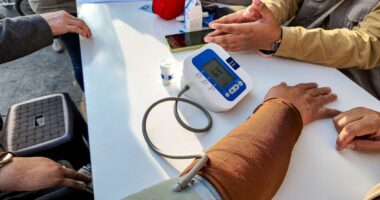Share this @internewscast.com
According to a recent study, subtle shifts in everyday driving habits could potentially signal the onset of dementia long before conventional medical tests can detect it.
Researchers at Washington University School of Medicine in Missouri discovered that data from in-vehicle GPS systems were more effective than age or traditional memory tests in identifying early signs of cognitive decline.
Individuals with mild cognitive impairment (MCI) showed a tendency to drive less frequently, avoid nighttime journeys, and stick to familiar routes. These behavioral changes became apparent early in the study and remained consistent over several years.
The research team suggests that these alterations in driving patterns could serve as a discreet indicator of brain health.
The study monitored 298 older adults, which included 56 individuals already diagnosed with MCI—a known precursor to dementia—and 242 participants who were cognitively healthy. The average age of the participants was 75 years.
Each participant drove at least once a week and consented to cognitive evaluations and the installation of a GPS tracker in their vehicle for the study’s duration.
Over a period exceeding three years, researchers monitored how often participants drove, how far they traveled, how frequently they exceeded the speed limit, and how much they varied their day-to-day routes.
Although driving patterns were similar at the outset, differences steadily grew over time.

Subtle changes in everyday driving habits may help identify people at risk of dementia long before traditional medical testing, according to a new study (stock image)
Individuals with MCI began driving less each month, drove less often at night and showed less variation in their routine travel patterns.
Using these driving metrics alone, researchers were able to predict MCI with 82 percent accuracy.
When demographic information, cognitive test scores, and Alzheimer’s-related genetic data were added, prediction accuracy rose to 87 percent.
Without any driving data, accuracy dropped to 76 percent.
‘Early identification of older drivers who are at risk for accidents is a public health priority, but identifying people who are unsafe is challenging and time-consuming,’ said lead author Dr Ganesh Babulal, an associate professor in the Department of Neurology at Washington University School of Medicine.
‘We found that using a GPS data tracking device, we could more accurately determine who had developed cognitive issues than looking at just factors such as age, cognitive test scores and genetic risk.’
Dr Babulal noted that monitoring everyday driving behavior offers a low-burden, noninvasive way to observe cognitive functioning.
He emphasized that early identification could allow for timely interventions before a crash or near miss occurs.
Research suggests that people with MCI or dementia may have elevated risks of crashes, poor driving performance, or other driving-safety problems.
One 2009 study by researchers at the University of Pisa found that individuals with MCI and those with mild dementia performed worse than cognitively normal older adults on tasks simulating real-world driving.
The ‘mean time to collision’ for mild dementia patients was reported as 0.5 seconds, compared with 1.7 seconds in MCI patients and 2.7 seconds in healthy controls.
Dr Babulal cautioned that such monitoring must respect individual autonomy and privacy and should be implemented ethically.

Driving behavior across frequency (eg, average distance), spatial mobility (radius of gyration), and destination variability (random entropy); x-axis depicts months (0–30) and y-axis depicts estimated mean (a–f)
The researchers also acknowledged a limitation: most study participants were highly educated and white, which may affect how widely the findings can be applied.
The study, published in the medical journal of the American Academy of Neurology, was funded by the National Institutes of Health and the National Institute on Aging.
MCI is common among older adults, affecting an estimated 17 to 22 percent of Americans age 65 and older, or roughly five to seven million people.
While not all cases progress, MCI is widely recognized as a risk state for dementia, especially when memory is primarily affected. Studies show that about 10 to 20 percent of people with MCI develop dementia each year, and roughly one-third of those with Alzheimer-related MCI progress to dementia within five years.
Dementia can compromise several abilities essential for safe driving.
As memory declines, drivers may become disoriented even on familiar routes.
Slower reaction times and difficulties with divided attention can make responding to traffic signals or sudden hazards more challenging.
Impaired judgment may lead to miscalculations in speed or distance, while weakened visual-spatial skills can make navigating complex intersections or recognizing traffic signs more difficult.
These changes tend to develop gradually, often showing up first as small modifications in driving habits, the very patterns the new study captured.
Driving regulations for individuals with dementia in the US vary by state but share common themes.
Many states require or permit physicians to report drivers diagnosed with dementia to the Department of Motor Vehicles, which may then mandate an evaluation.
Depending on the degree of cognitive impairment, drivers may undergo vision screening, written testing, or a functional on-road assessment conducted by a specialist.
Early-stage dementia does not always result in loss of a driver’s license; some states issue restricted licenses that limit driving to certain conditions, such as daylight hours or short distances from home.
Most guidelines recommend reassessing driving ability every six to twelve months once cognitive impairment is identified.
Dementia affects over seven million Americans, with rates increasing with age, and is a leading cause of death. By 2050, this number is projected to rise to nearly 13 million.
In the US, dementia is more common in women and older age groups, with prevalence rising significantly after age 85, and it disproportionately affects racial and ethnic minorities.













